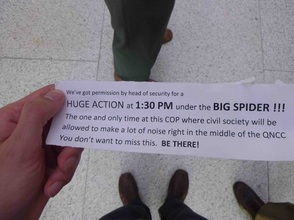 Nikki was handed a slip of paper containing the instructions to gather under the big spider at 1:30 pm as seen in the picture here. We arrived a bit early and tried to get set up and we immediately noticed the very large security presence. The hall was ablaze with ideas of what will take place. The hoards of media started jockeying for position as more security officers arrived.
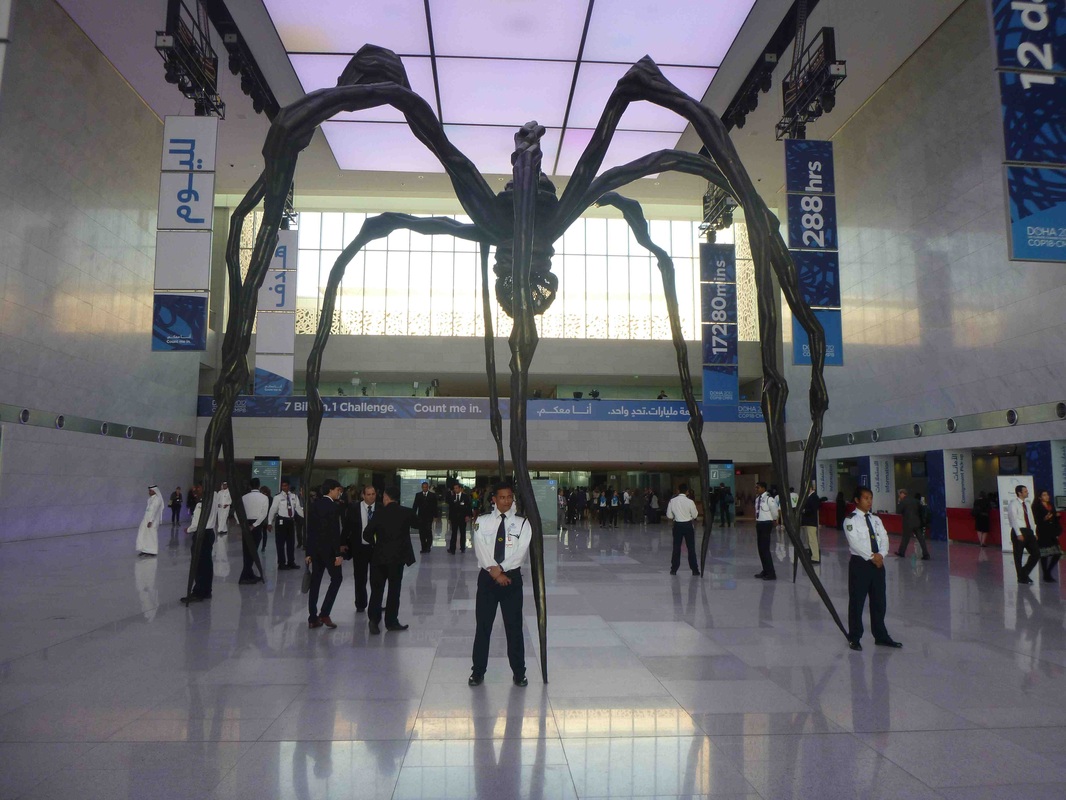
Security forces line up before the protests
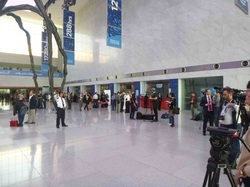 As you can see, by 1:00 pm there were 6 armed UN security forces, 8 members of a private security team, and 6 QNCC security forces. However, by 1:15 pm the security forces ballooned to 34 by my count with over 16 QNCC guards circling the spider. By about 1:30 pm we were starting to receive instructions. There will be a sing event for the climate. A picture of the lyrics is available below.
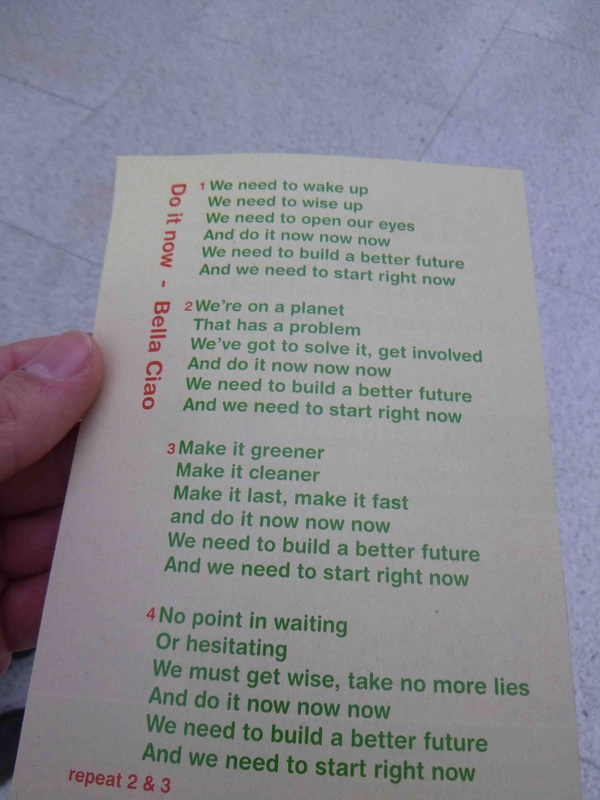
Lyrics for the climate song
The crowd erupted in a chorus of singing for the Earth. After the singing was complete, several leaders lead the crowd in chants, such as “Don’t Back Down.”
Perhaps, more interesting was the array of youth carrying signs throughout the hall. As you can see many of them directly question the US actions here.
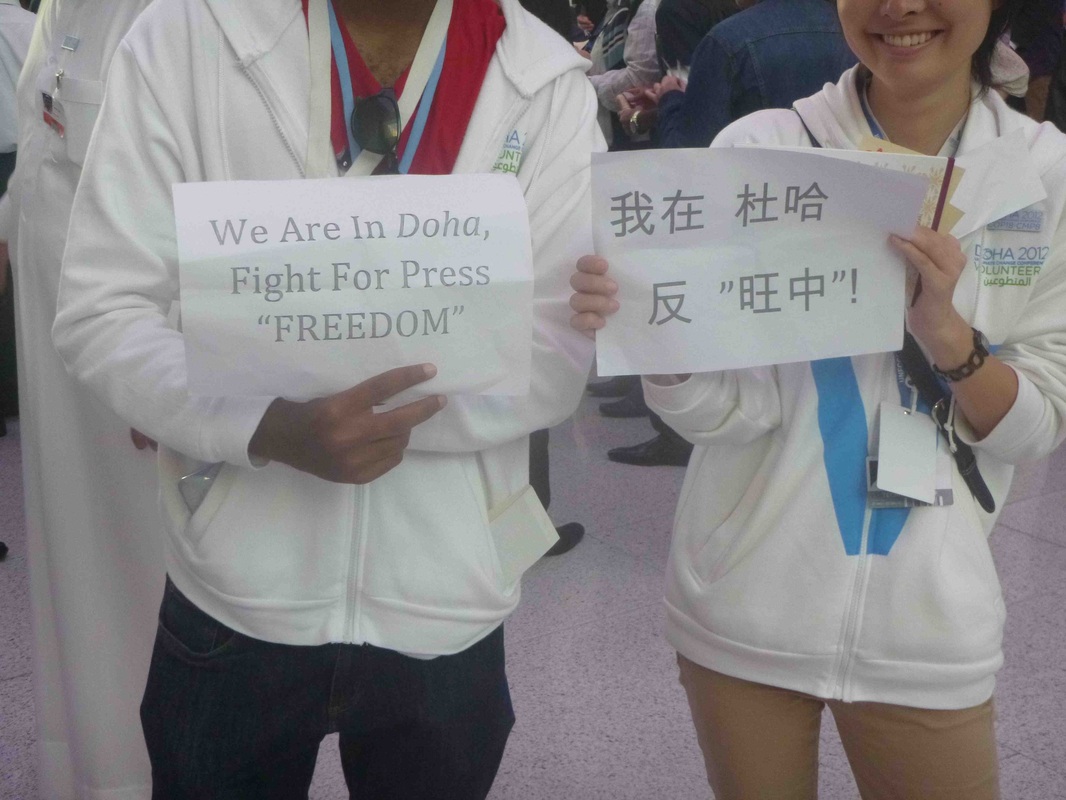
Two youth protest the previous day's events involving two you getting ejected from COP
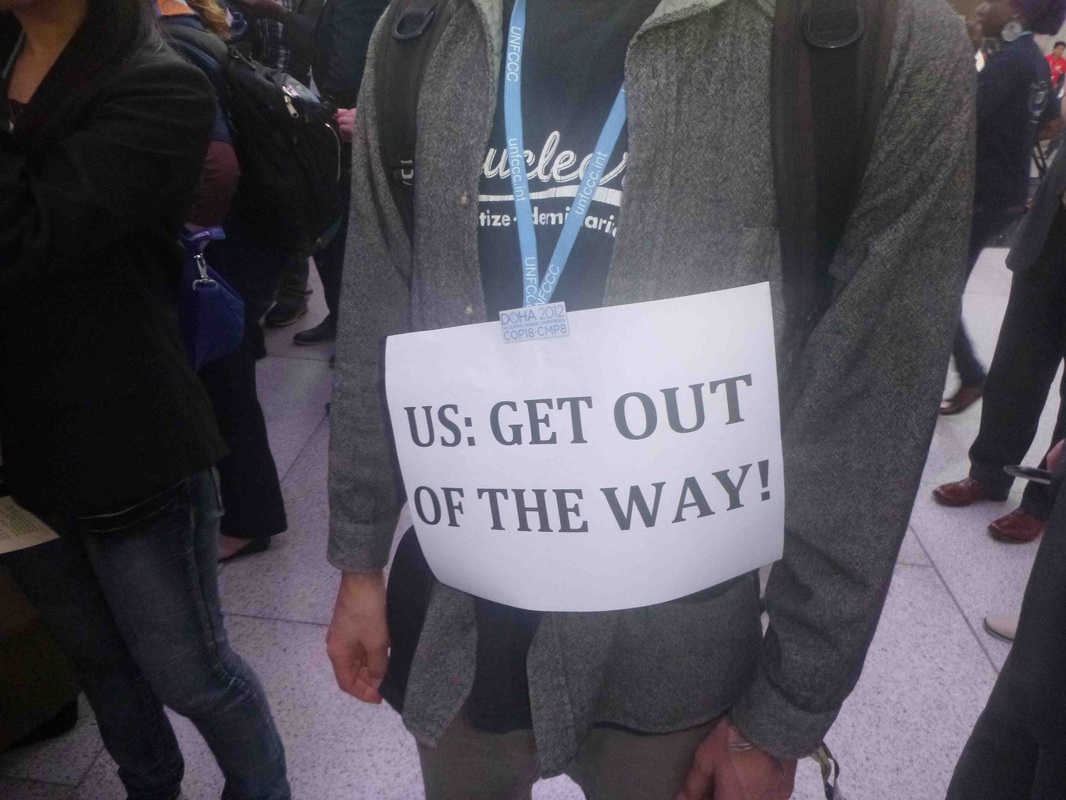
A youth is protesting US actions here in Doha
All of the Non-governmental organizations (me) are starting to close down and head out. The only thing that is left is to await the final press briefings. Over the last few days, many of the developed nations have cancelled all of their press conferences so we are eagerly awaiting the final results. I will keep everyone posted if anything exciting happens into tonight.
Below is a press release I just received on the Arab youth that apparently was deported for his actions at COP. “Qatar, Why Host, Not Lead?” The Young Arab Civil Society Questions Qatari Government Doha- Qatar, Dec 6, 2012 - Two young activists from IndyACT held a huge banner today at the central meeting point in the QNCC while the COP 18 UN climate change negotiations were taking place, to show their disappointment of the performance of the Qatari Presidency in the negotiations. Raied Gheblawi and Mohamed Anis Amirouche, were arrested and deported from Qatar on the same day. The banner stated "Qatar, Why Host, Not Lead?" to portray that the presidency can do more to advance the negotiations in the next 48 hours. If they don't, the talks could actually collapse. Qatar Presidency has the mandate to facilitate an agreement and take negotiations with ministers into the night and get a decent deal out of them. On a national level, they can also promise to do their part, by firstly cutting emissions and also putting the right finances to get things done. The youth clearly wanted to tell the Qatari Government that it’s still not too late to make a change! It’s each delegation’s responsibility to ensure a healthy future for the youth and so they find that now is the perfect time to shape this future ina healthy way. It is unacceptable that we still live in times when activists are not allowed to express their opinion and demand their right in living in a proper environment. Gheblawi and Amirouche were among millions of people who demand their governments’ everyday to save them from the impacts of climate change. They are just the sound of youth which will never be silenced. The big question remains, will there be a definite statement by the world leaders tomorrow and will Arab leaders specifically make a difference and pledge to reduce their emissions? The civil society wonders. For more info, please contact; Ali Fakhry Email: [email protected] Doha Number: 33684296 For more information, click here.
Although the Arab youth is gaining a voice here in Doha, there has been some push back. As you can see here, an Arab youth is taken away because he did not want to move his sign.
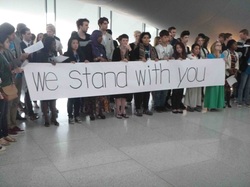 Youth standing together As I was walking back from the East Restaurant complex just outside the QNCC, I stumbled upon a large gathering. Many people were shouting and others were quickly snapping pictures and filming. On the receiving end of the incessant flashes was a group of youth holding a large sign that exclaimed: “We Stand With You.” The youth from all across the world are announcing their pledge to stand with the Arab youth in support of their calls to their leaders. Together they urge their leaders to make definite cuts to greenhouse gas emissions and pledge for renewable energy sources, such as solar. This protest in the main hall of the QNCC was a direct extension of the protest I attended last Saturday. It is great to see that the youth of the world are connecting and hope to continue their push.
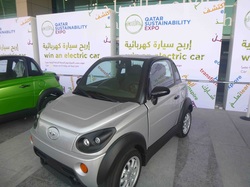 One of five cars up for raffle The next day we decided to finally make our way to the Doha Exposition Center, which is hosting the Sustainability Expo. After a quick 45 minute ride in the desert (due to traffic), we arrived at the Expo center. Let me tell you, this place is cool. In the front of the center there were 5 small electric cars that will be raffled off tomorrow. I’ll let you know if I win (I suppose it will take a while to drive it back, but I haven’t decided how I will cross the Atlantic Ocean yet).
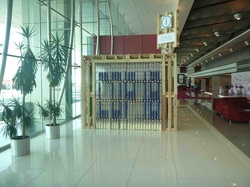 Information desk at the expo Next, we came across the information center, which had walls that were completely comprised of used plastic bottles. They painted some of them to say, “COP 18,” which was pretty cool. They have also used old water jugs as decorative art.
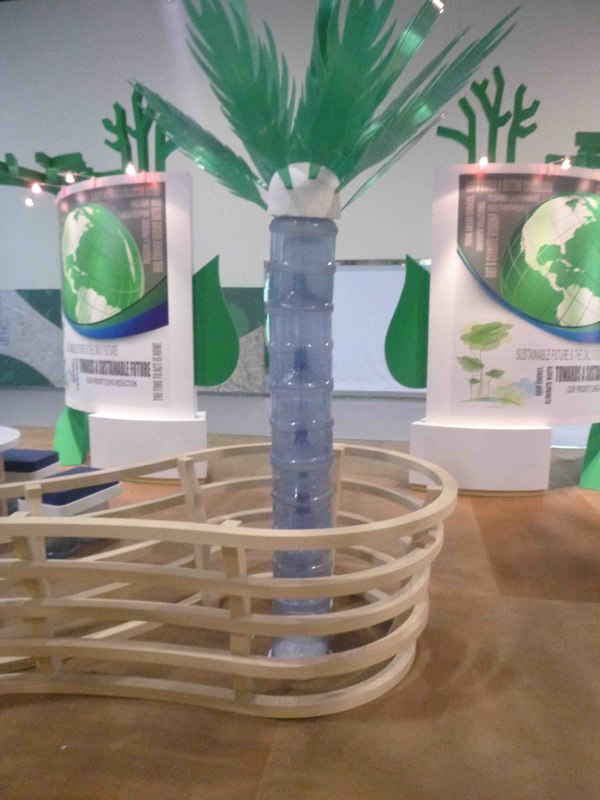 Water bottle tree  Roll Tide! Next I walked on over to Saudi Arabia (in the Expo center), and wrote “Roll Tide” on the sustainability in hopes that this trend will be sustainable throughout multiple generations. However, I would like to award the Kingdom of Saudi Arabia a gold star. Not only did they have Minority Report style touch screen, but they had tons of information about how Saudi Arabia (and the world) will look in 2050.
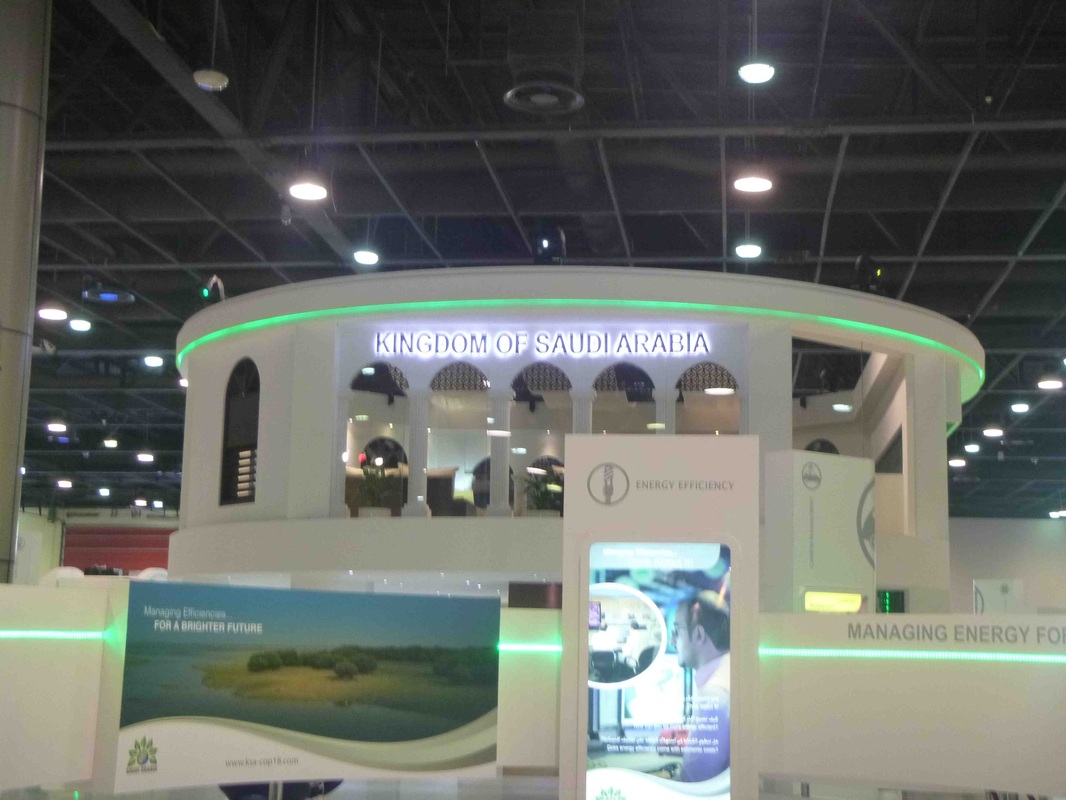 Kingdom of Saudi Arabia 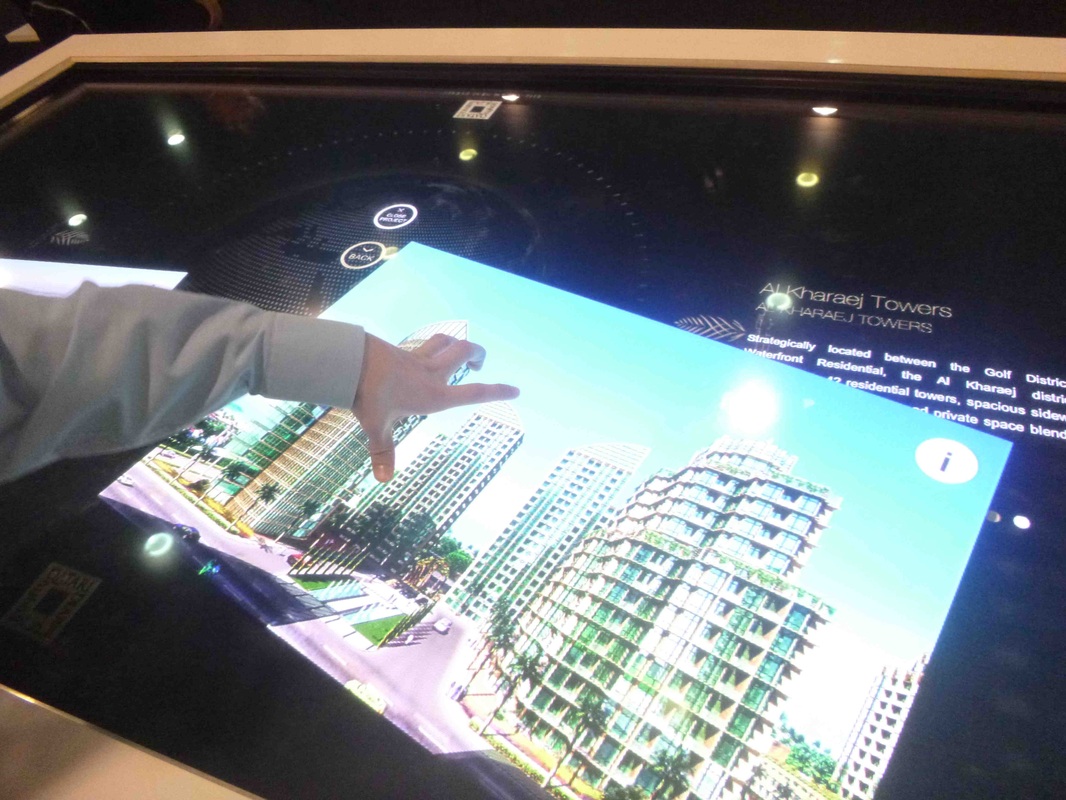 Minority Report! 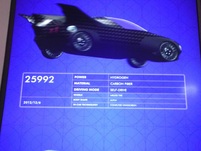 One of the cars I built One of the cool things was this cool interactive touch screen that gave information about city living in the future. Since we will all be living in Mega Cities, land will be at quite a premium. Innovative ways will be super high skyscrapers, living underground, and huge boats. Then I built my own car that will be powered by Hydrogen, have a carbon fiber body, and have airless tires.
Saudi Arabia did a great job in explaining and displaying some new, exciting technology including the mobile carbon dioxide capture system. It can be placed in the back of a truck and it essentially works by harnessing the exhaust and directing it through a high surface area powder absorbent that can capture the exhausted carbon dioxide. In addition, the vehicle was still “Built Ford Tough.”
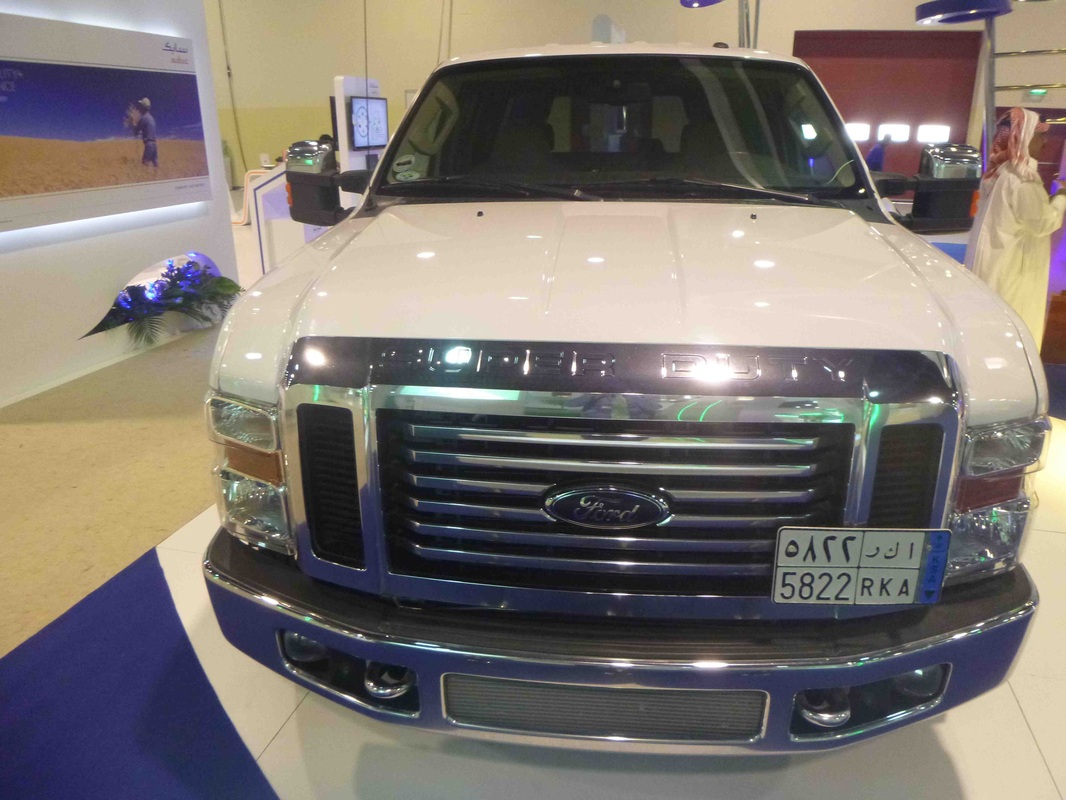 Ford truck holding the carbon capture system  Carbon dioxide capture system in the back of a truck 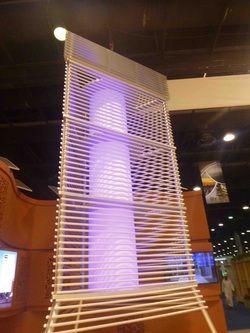 Wind tower in Masdar City There is also a project in Abu Dhabi known as Masdar City, which a planned “neighborhood” that will run only on solar and sources of renewable energy. For example, here is a replica of a wind tower that will help cool down areas through solar-assisted airflow. Since the wind tower is very tall, it creates a temperature gradient that will function to cool down the ground level without any electricity. Another cool idea was the personal rapid transportation in little pods, which I failed to take a good picture of (sorry!)
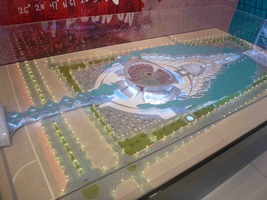 One of the planned venues for the World Cup in 2022 I then checked out the World Cup stadiums for Qatar’s 2022 event. If you didn’t know, all of the stadiums are being designed for maximum airflow, which allows them to effectively air condition the playing pitch. In addition, many of the stadiums will be modular and Qatar will disassemble them and move to developing countries so they too can have a stadium.
They also had vending machines that will accept recyclable cans and bottles. In addition, they give coupons and rewards for recycling. I am not sure what the coupon we received was good for though as it wasn't very descriptive. We also may have stolen that can so we could recycle it.
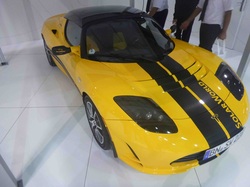 A final thing I will show off, is the new solar powered sports car from Tesla that was displayed at the expo.
As I wrote this I realized that a majority of this stuff might have been for children, but I enjoyed myself nonetheless.
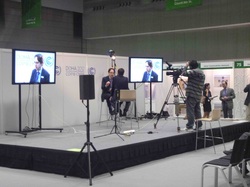 I can hardly walk through the halls of the QNCC without tripping over someone being interviewed or a group of the media setting up. I have not been mistaken for anyone important so I have not yet been stopped for questioning, but I continue to walk around with a sense of purpose and haste so there is still hope. I will start planting stories that I am an important USA negotiator. Wait. I look like I’m 14 so I might have to settle for the “son of a Duke or a Lord,” which could work as long as I don’t speak past my excellent British “Ello.”
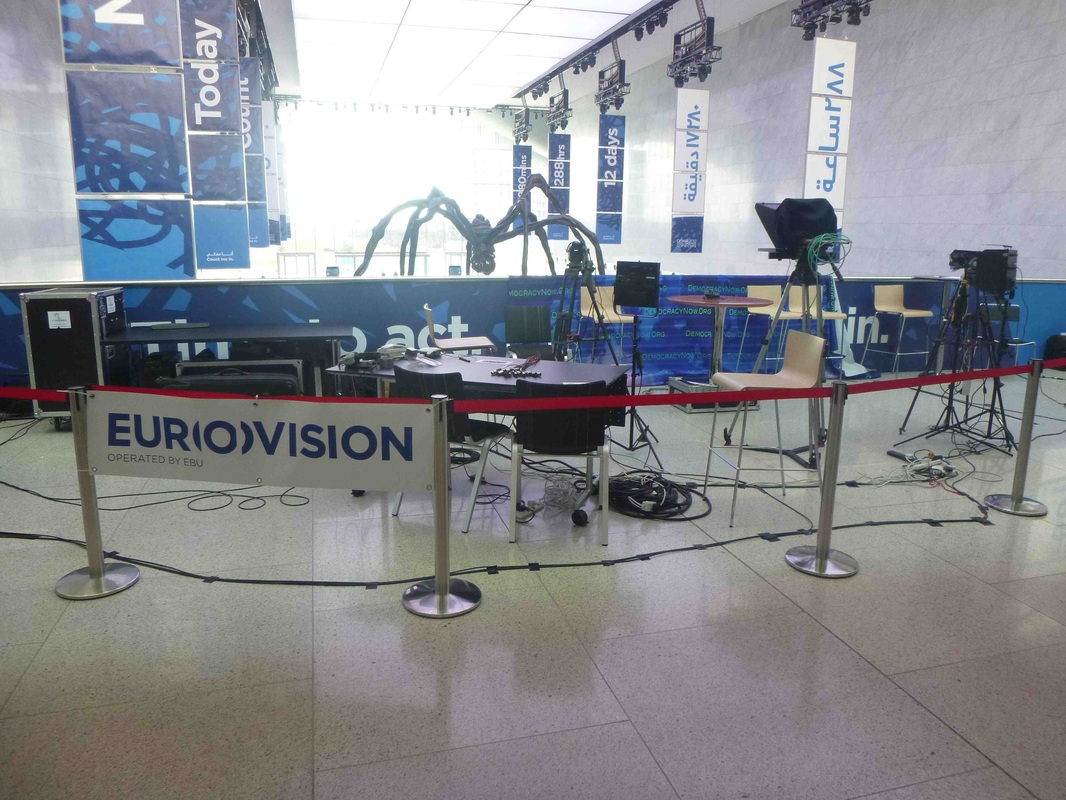 Eurovision Booth in the Main Blue Hall of QNCC 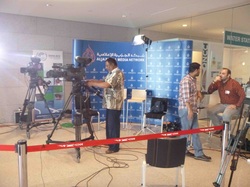 So far, I have been able to see news crews from all around the world. I saw SkyNews interviewing the British Minister of State for Climate Change, the Rt. Hon. Gregory Barker, MP. Al Jazeera has a large presence for both its English and Arabic stations. I have even seen a variety of news stations in Spanish, Portuguese, Arabic, Japanese, and even Chinese. We were even featured in a Huffington Post article. However, I have not seen any news stations form the USA. CNN, MSNBC, FoxNews, and ABCNews are all mysteriously absent save for some editorials as shown here and here. In fact, I have also been able to meet a variety of foreign leaders (and by that I mean I saw them talking in a crowded convention center room). As already mentioned the British Minister of State for Climate Change, the Rt. Hon. Gregory Barker, MP (he certainly has a few titles) is present as is the Italian Minister of the Environment, Corrado Clini, also addressed us today. The sad truth is that a lot of important members of many countries are present while the USA leaders are absent.
 Could they have been scared by the potential culture shock? I don’t think that is possible. McDonalds, KFC, Burger King, Dunkin’ Donuts, and Coca-Cola are all present. McDonalds even delivers! What more could a guy want? The cafeteria serves pizza around the clock. Everyone, save for our Arabic hosts, are clad in Western business attire (from business suits to the scattered few wearing jeans). Water stations are even available for the thirsty traveler.
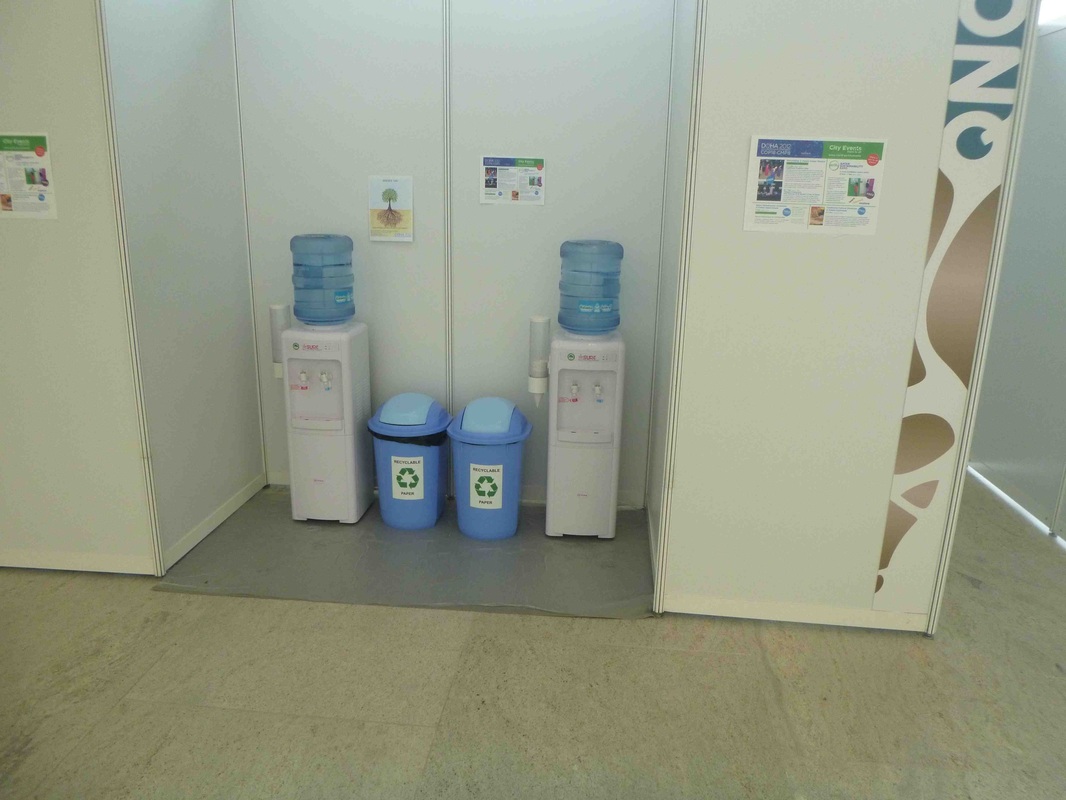 A true oasis in the desert of Doha 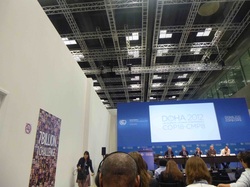 Terrible acoustics in each of the side event rooms I will say that the acoustics in the side events rooms are terrible. We are set up into makeshift rooms that, while well stocked with microphones and technology, do not have walls that reach the system. As a result, I can clearly hear a few rooms over, which makes hearing the speaker in your chosen side event room quite challenging.
The plenary room 1, which I was able to successfully sneak in through a series of covert operations that even Tom Clancy may write about in an upcoming novel, does not suffer from the same downfalls. In reality, I just walked in while someone else was asking the doorman a question, but still, by my estimation at least, an exceedingly clever move.
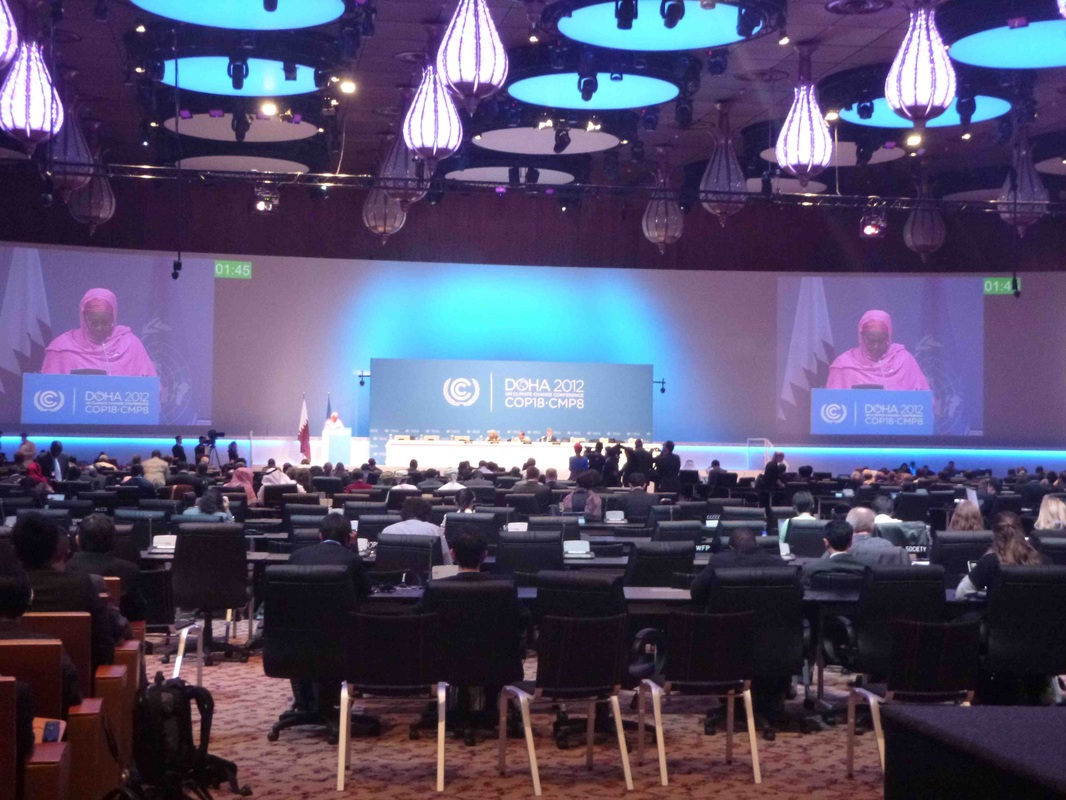 Plenary Room 1 while in session Through a second equally as cunning act of subterfuge, I also was able to walk into Plenary Room 2, which is closed for special meetings. Essentially, I walked right in with a phone up to my pretending to talk to my “editor.” In fact, there were no guards here so my actions were not quite necessary. As you can see, the United States has a “white” designation, which means that we have no voice in the room and are only acting as observers.
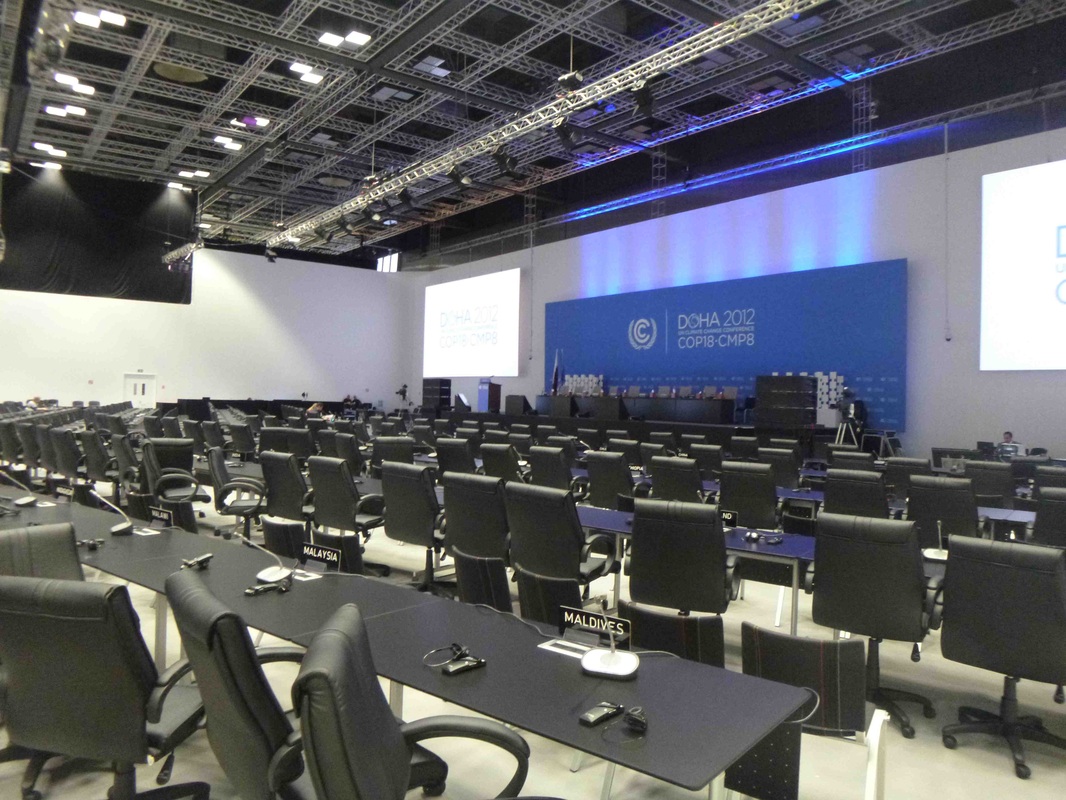 Plenary Room 2 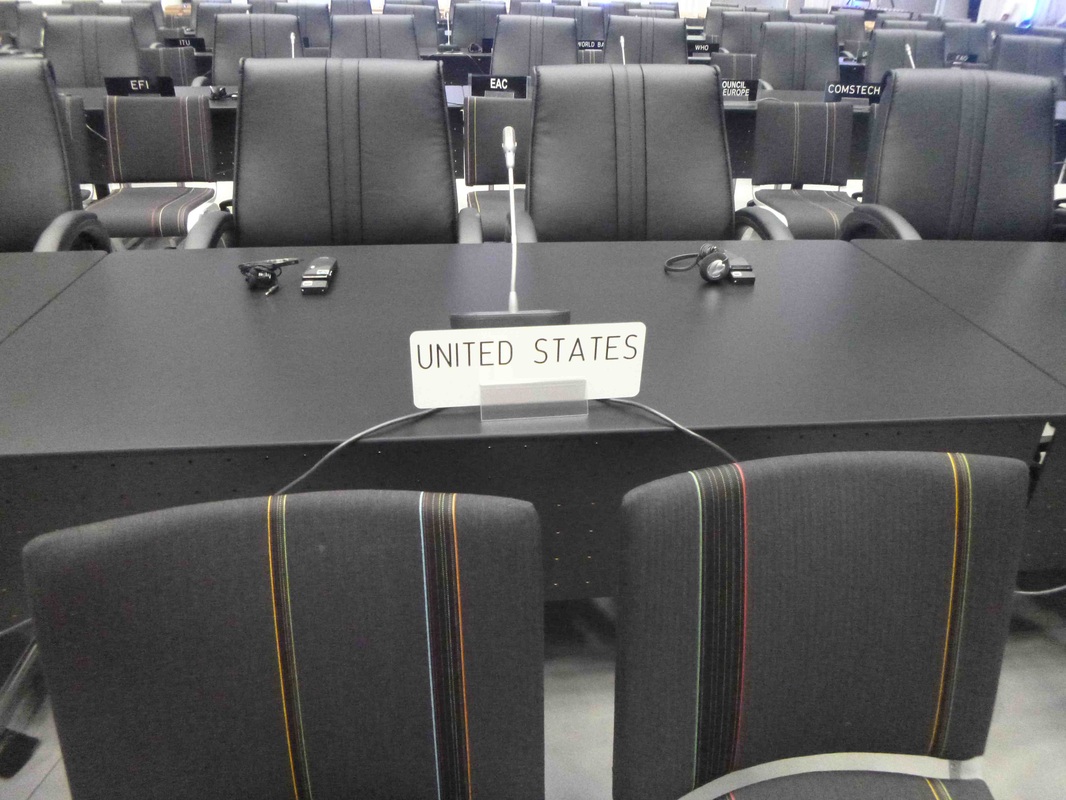 USA's white name holder As a result, I am disappointed to report that many of the important nations are not expecting anything major to be decided this year. With their eyes on 2015 (the year at which the international community hopes for an international deal to be in place), many nations chose instead to focus on domestic issues. Who can blame them though? The USA has no shortage of domestic issues currently. However, I would hope for a more of a buzz about COP18 in the USA.
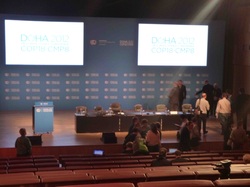 I was able to snag a plush seat in the Press Conference Room to hear Russian Special Envoy, Alexander Bedritsky, address the media. It is interested that the USA and Russia both sent “special envoys” instead of heads of departments throughout the government. US special climate envoy Todd Stern cancelled his media address, but will address the Non-Governmental Organizations later this afternoon (me!).
So, are you hearing about the conference in the USA? Why do you think that the USA is not present?
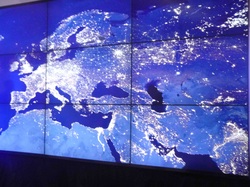 While the majority of the debate has shifted from whether or not climate change by humans is possible to how to prevent climate change, a major policy debate still remains. Should governments regulate greenhouse gas emissions and require more environmentally friendly industries or should the market be left to regulate itself to allow the general population to request greener products? Each have their own pros and cons as a strategy to prevent anthropogenic climate change.
For example, many detractors of the national climate change bill strategy have pointed to the general lack of effectiveness and low efficiency of large centralized governments including many national U.S. departments that are currently under increasing scrutiny during our recession and impending fiscal cliff. On the other hand, allowing the markets to self-correct has also been argued to be too slow or impractical as the cheapest ways of producing energy (in terms of money) are the dirtiest and release the most greenhouse gases, which will not allow for a quick energy transformation.
One of the events I went to today was focused on providing case studies for Mexico, Denmark, and China, which all have made great strides in either drafting (China) or signing national legislation (Denmark and Mexico). Denmark has been a key leader in proposing and agreeing on actual goals for renewable energy. For example, their commitment to utilize 100% renewable energy sources by 2050 is an excellent idea, but they are also creating and meeting milestones through green energy technology and becoming more efficient as a society. Mexico recently passed a comprehensive climate change bill as China is currently seeking to draft its own.
With the Waxman-Markey climate change bill currently dead in the water, the United States is not currently making progress for a comprehensive bill, but is making incremental and encouraging progress in several key areas. One interesting aspect is the regulation the EPA has successfully implemented on miles per gallon restrictions. While there was some initial claims that these restrictions would kill the US auto market, it may be responsible for its reemergence as a viable international industry. If you take a look at Ford, it immediately starting allowing its economic model to evolve even the anticipation of potential regulations has recently instituted many green initiatives. (Check out some of the cars in the 2013 Ford lineup if you don’t believe me). In fact, the newly released EPA restrictions calls for an average of 54.5 mpg by 2025, which would save the consumer $8000 in gasoline costs over the lifetime of a newly purchased car, which helps to drive consumers to buy new cars. While many would argue that this is merely driven by consumer demand, the anticipation of potential regulations is a large factor at play as well. If we look at the case study of Denmark, they set very strict goals for greenhouse gas emissions and are leading the charge to be powered by 100% renewable energy by 2050. Many US states are also adopting their own measures, such as California, which has its own comprehensive climate bill. Arguing that a climate change bill would kill the US economy is flawed as it would only ruin unhealthy businesses that are unwilling to adapt. In fact, as shown by the EPA mpg restrictions, a comprehensive climate change bill could help the overall economy by providing more advanced alternatives. Another initiative directed by the US government was to double the renewable energy output, which has already been accomplished in large part due to the new wind energy initiative that not only creates renewable energy, but does so by utilizing over 70% of American made parts. Two new nuclear plants are being built in Georgia as well. In fact, the development of these new energy sectors leads to the creation of hundreds of thousands of jobs. Nuclear power alone creates nearly 500 jobs per 1000 MW capacity of energy output, which is more than all of the sectors. In Obama’s speech after the 2012 election, he said (transcript available here): We want our kids to grow up in a country where they have access to the best schools and the best teachers a country that lives up to its legacy as the global leader in technology and discovery and innovation with all of the good jobs and new businesses that follow.
We want our children to live in an America that isn’t burdened by debt, that isn’t weakened up by inequality, that isn’t threatened by the destructive power of a warming planet.
-President Barack Obama
All of these things can be accomplished by the anticipation of climate legislation as well as the binding legally commitment that will spur the development of the new, sustainable US economy. Without the legally binding commitment, progress will slow. Innovation of new products and the increased efficiency called for in this bill will not only help pave the way for a cleaner globe, but also will help lead to a global deal with the United States leading the way.
Attendees hurriedly jostled for position through the main halls of QNCC, the home of the COP18 program, while darting in and out of meeting halls and individual focus groups. I dodged, bobbed, and weaved through the crowds as I tried to establish some semblance of a morning routine in order to plan the day. Sipping coffee and looking over the day’s program, I immediately starting creating a mental list of the events I wanted to learn more about. However, after each new talk or booth I attended, I was crossing off and amending the schedule. Thus, if I had to give a phrase that would best describe my initial experiences on what I would consider the first “real” day at COP18 it would be: “information overload.” Everything in the convention center, if taken all at once, could be considered overwhelming. The other bloggers and I attempted to divide and conquer the day’s events and attend as many talks as possible.
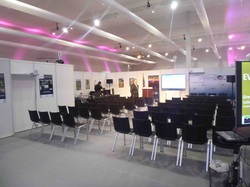 One of the first things I explored was the official pavilion for a variety of countries that opted to participate. While USA is typically chided for its position on climate change policy (which is actually a much more complex issue than it is given credit for), its role as the leader in climate research can’t be denied. While the USA does not agree on some of the market forces being proposed by the UNFCCC to regulate greenhouse gas emissions, its funded climate research drives much of the proposed legislation. The USA pavilion seen in the picture here, gave several presentations throughout the day hosted by a variety of institutions including the EPA and NASA including EPA’s role in monitoring and reporting mechanisms for greenhouse gas emissions in the USA. All of the talks at the USA Center are posted online and streamed live here.
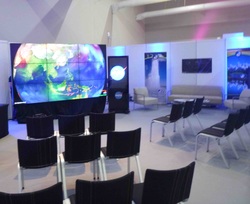 Perhaps the most interesting aspect of the USA pavilion was the NASA Hyperwall (it even sounds cool), which was a huge TV that was loaded with a variety of climate related data and models. All of the data and models are freely distributed over the web and can be found here. Its mission is to enhance data outreach through visualization techniques, which I found extremely interesting a refreshing take on simply publishing hoards of data. Another outcome of my discussions at the NASA Hyperwall are based on the measurement of the isotopic dilution of carbon-13 in the atmosphere, but deserves its own blog at a later date.
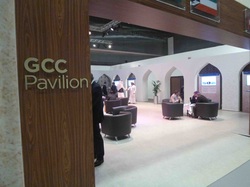 The Gulf Cooperation Council (GCC, including countries such as Qatar, Saudi Arabia, and Kuwait among others) got the award for the best decorated pavilion stocked with waiters, free coffee, and swanky architecture. However, in all seriousness the GCC has done a great job in sharing some of its efforts in carbon capture, enhanced oil recovery, and other techniques designed for higher efficiency and a net decrease in greenhouse gas emissions.
A second point I’d like to highlight would be the market-based mechanisms for creating a net decrease in greenhouse gas emissions, which is I believe the biggest driver in countries not signing the Kyoto protocol originally and the reason why a new protocol has not been agreed upon yet. While it is generally implied that the countries that did not sign the Kyoto protocol simply did not want to cut greenhouse gas emissions or did not believe it was necessary, in many cases the bigger sticking point was and still remains on how this would be done and its regulation. In order to simplify the blog post, I will overgeneralize the various viewpoints in order to discuss them more informally. The goal of the carbon market mechanism is to assist DEVELOPED countries for meeting greenhouse gas emission reductions. Two main ways this is accomplished is through two strategies sectoral crediting and sectoral trading. Sectoral crediting is the process of awarding credits or rewards for meeting defined goals. Sectoral trading is establishing a trade system that assigns fines for not meeting reducing goals, but is not necessarily a cap and trade system. While each country has its own strategy to help drive market mechanisms (or if they are needed), an area coming under intense scrutiny is in how these systems will be overseen and implanted. There are essentially two main and polar opposite approaches: a top-down approach or a bottom-up approach. In the top-down approach, the UNFCCC acts as a governing and legally binding entity with a more centralized framework. Many developing nations and the EU favor this type of an approach as it allows for continuity, common accounting practices, and common environmental integrity as a single body is evaluating the technical merit and emissions reduction. The UNFCCC would then be responsible for issuing credits and fines. An opposing view would be the bottom-up approach, which allows each individual country to set its own methods to reduce greenhouse gas emissions and issue its own credits and fines. This strategy is favored by the USA, Japan, and New Zealand. However, the UNFCCC argues that this will lead to carbon market fragmentation with different values for the credits and fines as well as inconsistent environmentally integrity. A recent paper, linked here, discusses the challenges and all of the potential design strategies to reach a framework consensus. Unfortunately, of all the people I heard speak today, none were expected any major decision with regards to the carbon market mechanism, which continues to act as burden to industries seeking regulation certainty. As I mentioned in an earlier blog, the USA (and most of the industries around the world) will not commit to any greenhouse gas emissions until it is economically viable and consistent. This is why the USA continues to lead in research and development, but has not yet committed to an exact greenhouse gas emission reduction.
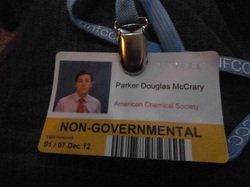 As the Qatari National Convention Center was closed today, there were no scheduled meetings or side events for the COP18 program. The new arrivees were not able to obtain UN accreditation yet either, but just to rub it in a little, I arrived a day earlier already have my accreditation and badge. Since many of us were quite jet lagged still we decided to take it easy and explore the city of Doha and partake in the local culture.
After a quick search for a decent cup of coffee we were off to tour the Souq Wakif to try to find some Qatari pearls (still MIA by the way). After touring the Souq, we walked down the Corniche Street “boardwalk,” along the Persian Gulf on a beautiful cool winter day in Doha. Even though Doha is not the most pedestrian friendly city (that is being quite generous, besides how can you even cross a round-a-bout anyway?), it was quite a fun experience. We even saw the Emir of Qatar taking his host of camels out for an afternoon jog. At least we thought it was the Emir. I even got a “Roll Tide!” from a passerby. This might be the most unique place I received a “Roll Tide” from a complete stranger: walking though the Souq Wakif enroute to the Persian Gulf. Tomorrow, we start the regularly scheduled programming for the COP events for the final week. I am going to head to the YOUNGO meeting bright and early and will get involved in some of the final events. Here is a link the schedule for side events. If anyone is interested in a particular side event, let me know and I can try to go and summarize or ask a question you might be interested in. 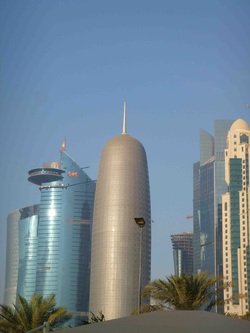 For a special treat, take a look at what the locals call the "Corndog" tower to the right of the World Trade Center - Doha. It must be LSU HQ. It is one of the 1000 or so skyscrapers currently under construction in the heart of Doha. We still haven't figured out what companies will actually do in all of these buildings.
Upon landing at Doha International, I was whisked away to the terminal in a bus. Despite being sleep deprived and eagerly looking at everything with my head on a swivel, I noticed that the bus we were on was extremely quiet. Right as I was coming off the high of my initial exploration in the Middle East, I found my self starting to doze off when I was abruptly awoken by the sound of a diesel engine turning over as the bus reached the appropriate speed. I was not riding on a special Qatari silent bus, but a hybrid bus. In fact, the Middle East was perhaps the last place I would guess that I would find a hybrid vehicle. I thought, “with gas at just under $1/gallon, what’s the point?” I always imagined that they might be having impromptu gasoline fights like in Zoolander in between trips to the Qatar Central Bank.
While the use of a hybrid bus to bring passengers to and from planes at Doha International Airport is a nice start, I also learned that Qatar leads the world in carbon dioxide emissions per capita (in fact over 2X the per capita emissions of USA). Due in part to the high need for air conditioning, desalination for potable drinking water, and as much lawn care as Central Park (surprisingly Qatar has quite a bit of manicured Bermuda grass with a few scattered palm trees), Qatar is an excellent example of a country that is acting to become more sustainable instead of merely talking. Its efforts in hosting the conference are a gesture that the United States should keep in mind if we aim to stay a leader in environmental legislation and technology development.
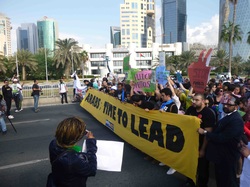 My first experience at COP18 was participating in a youth demonstration along Al Corniche St, a unique boardwalk street along the Persian Gulf. A video is available here. “Arab Leaders Unite” and “Your action, our survival,” we chanted as we walked down the street carrying signs, dressed as polar bears, and posing for pictures. Journalists darted up and down the street snapping pictures and filming the rare Qatari protest. To put the uniqueness of the protest into context, apart from a recent government sponsored protest, many ex-pats living in Qatar could not remember the last protest in Doha. I found the chant, “Your action, our survival,” the most poignant and interesting. Those meeting behind closed doors as you read this post will be long dead by the time the outcomes from these decisions are known. And they are deciding YOUR future. Various Arab youth organizations, as the organizers of the event, were demanding their leaders give them a voice and asked them to agree on specific reduction goals. The turnout was quite promising among the attendees (close to a thousand if I am being generous), but was even more surprising among local and international news outlets (which I guess includes me now!) This was most likely an even more important aspect of the protest. Hopefully this will echo across the world to the youth of every nation.
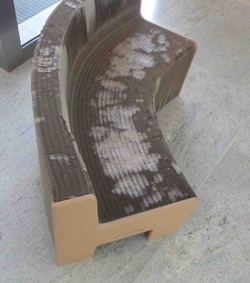 After the protest, I headed to the convention center via a very organized mass transportation system with an army of volunteers. I obtained my security badge and headed inside the center. For those that have been to a national ACS meeting, the conference center was organized very similarly with an exposition hall and a variety of meeting rooms with a multitude of different topics of varying levels of international importance. The break areas were even equipped with chairs made out of recycled cardboard (yes, they were structurally sound as far as I could tell.)
The first side session I attended was focused on developing a sustainable transportation network in sub-Saharan Africa. Important people in the field, such as the Director of Transportation in South Africa, Minister of Gender and Development of Liberia, among others were present for the discussion and to share experiences in developing new mass transit networks in the developing continent. While this issue hasn’t impacted CO2 emissions as much as a New York City or Beijing traffic jam, with the increasing urbanization and development of African cities, people are moving from transit by foot to a car in every garage. Leaders of Africa are attempting to break these habits before they set in.
The second side session I attended discussed Lebanon’s aggressive stand on developing renewable energy technologies and utilizing sustainable energy sources. I found the development of Lebanon’s smart grid particularly interesting. They will have electronic monitors on every house in the next 2 years. This allows access to an immense amount of data to continue to help “Smarten” the electronic grid. Lebanon reached its goal of using renewable energy for 12% of its energy needs. Unfortunately, the government has to still subsidize electricity as the use of renewable sources causes the prices to raise. It was estimated that the price was $0.35, but the consumer paid only $0.10 per kW. This touches on a previous blog post by me that I believe Americans will not fully adopt the renewable and environmentally friendly agenda until market forces make the green technologies cheaper.
A blog post highlighting our upcoming travels to Doha, Qatar is now posted on the ACS Undergradaute Blog. Make sure to check it out! I am now enroute to Doha. Stay posted for more updates!
|







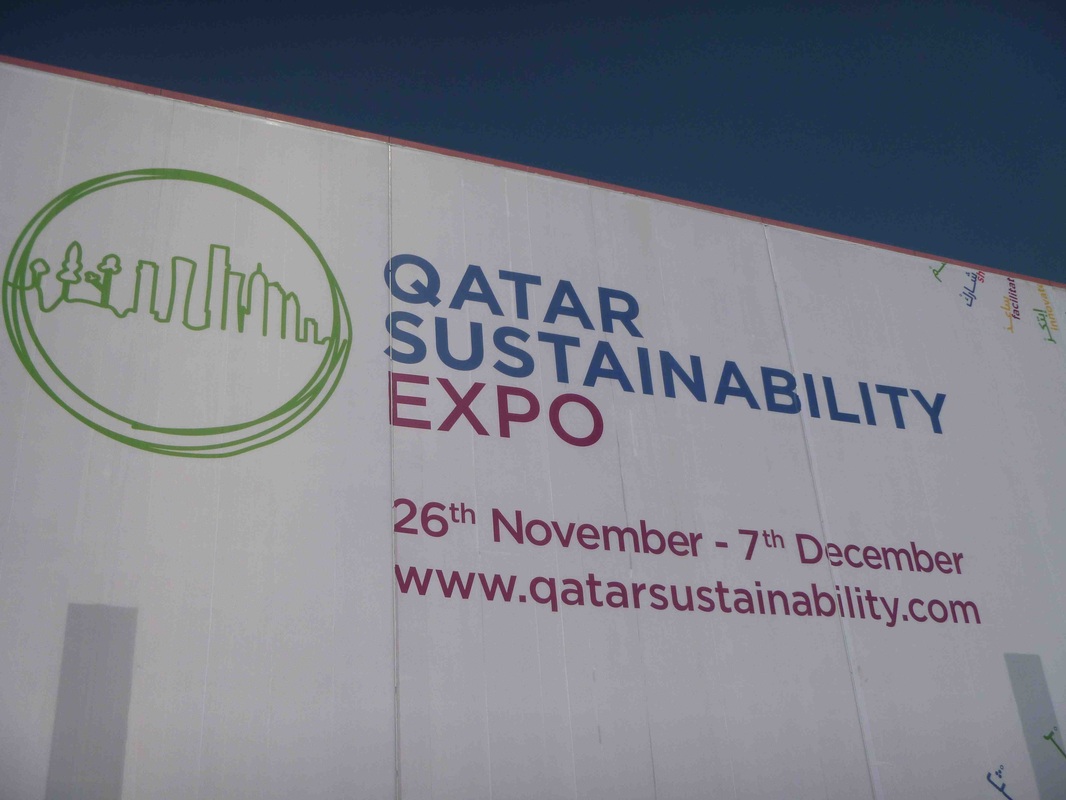























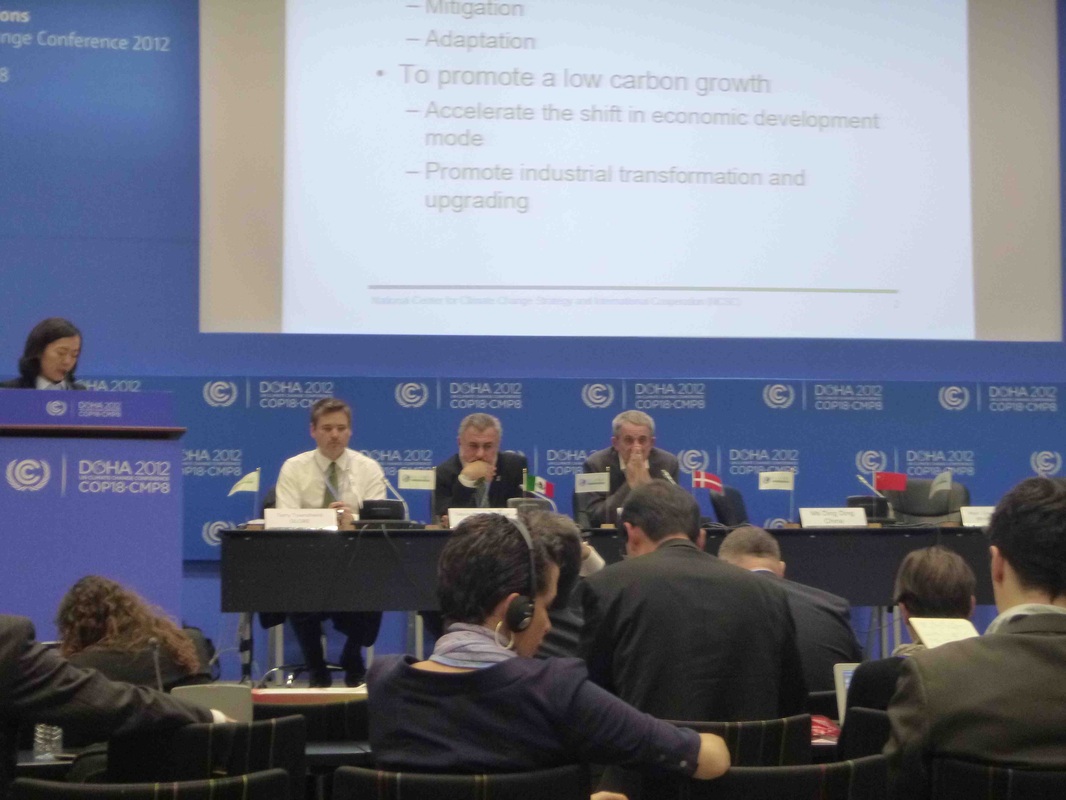




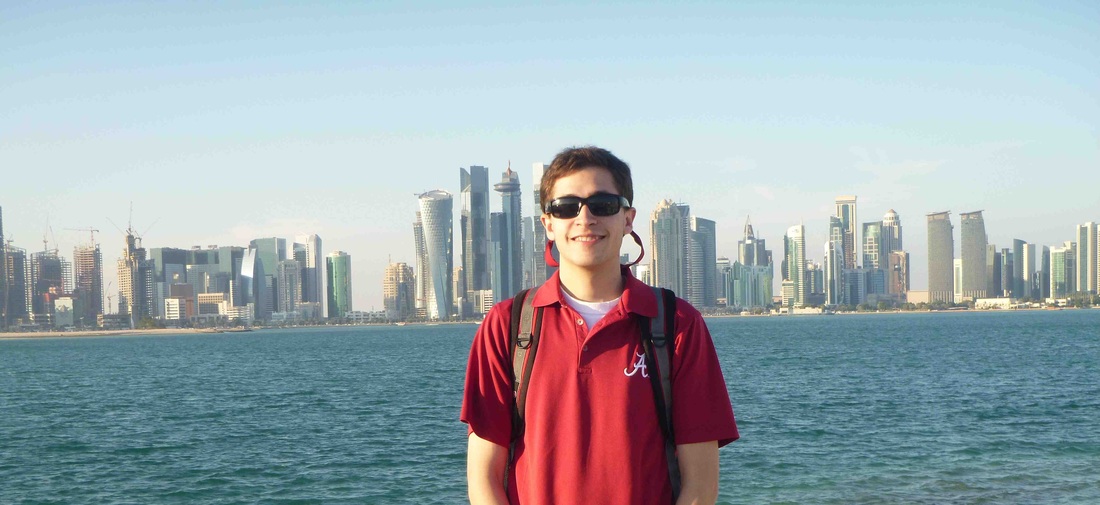

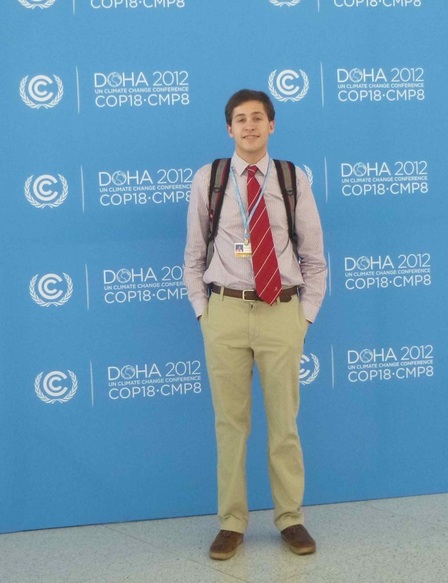


 RSS Feed
RSS Feed